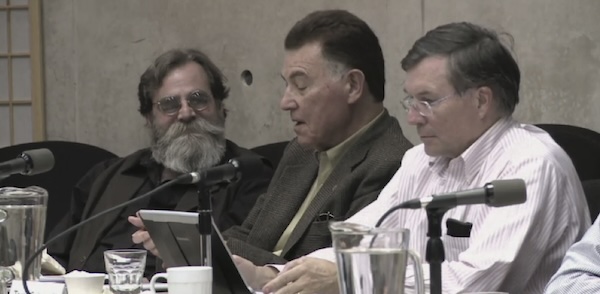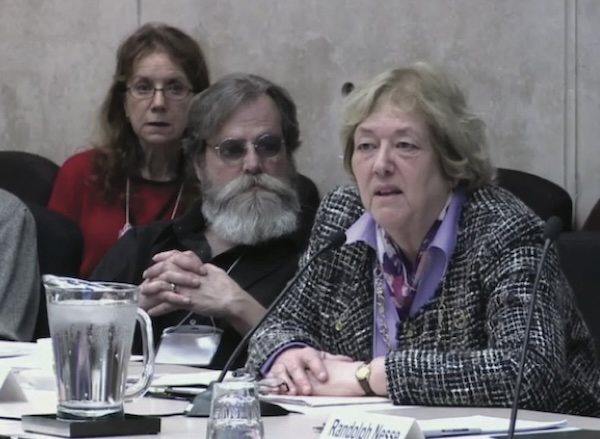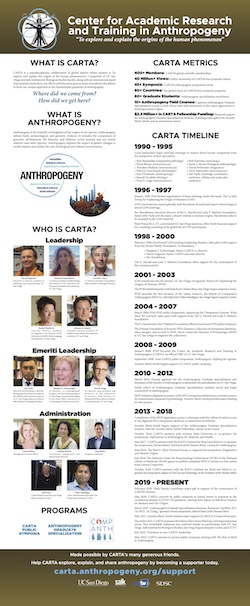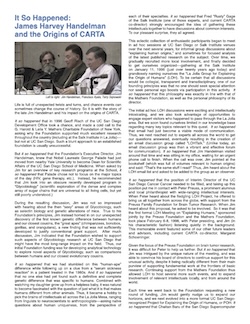History of CARTA
Researchers in diverse fields related to anthropogeny began meeting in the La Jolla area in the late 1990s, an effort coordinated by the UC San Diego Project for Explaining the Origin of Humans (POH). The group consisted of experts in San Diego and many others from around the world. The primary activity of the group was to organize transdisciplinary meetings in La Jolla, and to facilitate interactions via the internet.
As many intellectual and practical opportunities surfaced, the original Project was re-established in January 2008 as a formal Organized Research Unit (ORU) at UC San Diego and in close collaboration with interested faculty at the Salk Institute for Biological Studies. Thus, the Center for Academic Research and Training in Anthropogeny, or CARTA, was founded.
CARTA is a larger and more publicly active research program than POH, and one that facilitates graduate and postgraduate education in relevant departments and programs to equip the next generation of scholars who will formulate and address questions concerning the origins of humanity.
Learn more:
1990 - 1995
Local researchers begin informal meetings to inquire about human uniqueness from the perspective of their specialties:
- Kurt Benirschke (comparative pathology)
- Floyd Bloom (neurosciences)
- Theodore Bullock (neurosciences)
- Patricia Churchland (philosophy)
- Roy D’Andrade (anthropology)
- Russell Doolittle (biology)
- Fred H. Gage (neurosciences)
- Bob Katzman (neurology)
- James J. Moore (biological anthropology)
- David Perlmutter (linguistics)
- Terry Sejnowski (neurosciences)
- Ajit Varki (meetings coordinator; medicine; cellular and molecular medicine)
1996 - 1997
January 1996: First formal organization of these meetings under the name, The La Jolla Group for Explaining the Origin of Humans (LOH).
LOH conversations expand globally with the advent of email and expert visitors begin to attend LOH meetings.
Jim Handelman, executive director of the G. Harold and Leila Y. Mathers Foundation, meets with Varki and discusses a shared interest in human origins. Handelman asks to be included in the LOH email list.
Peter Preuss M.A. ’67, a prominent UC San Diego alumnus, offers Varki financial support for a meeting consisting of the global list of LOH participants.
1998 - 2000
February 1998: First formal LOH meeting, Explaining Humans, takes place with support from the Preuss Family Foundation. In attendance:
- Margaret J. Schoeninger, future CARTA co-director
- Pascal Gagneux, future CARTA executive co-director
- Jim Handelman
The G. Harold and Leila Y. Mathers Foundation offers support for the continuation of this unusual activity.
2001 - 2003
LOH transforms into the formal, UC San Diego-recognized, Project for Explaining the Origins of Humans (POH).
The POH website launches with help from Chaitan Baru, San Diego Supercomputer Center.
POH launches the first iteration of the online resource, the Matrix of Comparative Anthropogeny (MOCA), with help from Vishu Nandigam, San Diego Supercomputer Center.
2004 - 2007
March 2004: First POH public symposium, Sequencing the Chimpanzee Genome: What Have We Learned?, takes place with support from The G. Harold and Leila Y. Mathers Foundation.
The G. Harold and Leila Y. Mathers Foundation offers to fund more POH public symposia.
The Primate Foundation of Arizona (PFA) donates a collection of chimpanzee skeletons, other samples, and records to POH, which creates the Museum of Primatology (MOP) at UC San Diego to organize the collections.
2008 - 2009
January 2008: POH becomes the Center for Academic Research and Training in Anthropogeny (CARTA), an official ORU at UC San Diego.
September 2008: First CARTA public symposium, Anthropogeny: Defining the Agenda.
Annette Merle-Smith begins support of CARTA public symposia.
2010 - 2012
March 2010: Formal approval for the Anthropogeny Graduate Specialization and formation of the Faculty of Anthropogeny to administer the specialization at UC San Diego.
Initial cohort of Anthropogeny Graduate Specialization students enroll and begin coursework in anthropogeny.
MOP initiates a digitization project of the PFA chimpanzee skeletons as a virtual resource for research and comparative primatology. Annette Merle-Smith provides major funding for this project.
2013 - 2018
Completion of the MOP digitization project culminates with the rollout of online access to the digitized PFA chimpanzee skeletons to researchers worldwide.
Annette Merle-Smith begins support of the Anthropogeny Graduate Specialization students with the Annette Merle-Smith Fellowship, named in her honor.
October 2016: CARTA partners with Arizona State University to co-sponsor the symposium, Implications of Anthropogeny for Medicine and Health.
May 2017: CARTA partners with the KAVLI Institute for Brain and Mind to co-sponsor the symposium, Extraordinary Variations of the Human Mind: Lessons for Anthropogeny.
June 2018: The Paul G. Allen Frontiers Group co-supports the symposium, Imagination and Human Origins.
July 2018: The National Center for Biotechnology Information (NCBI) of the National Library of Medicine (NLM) agrees to publish completed MOCA entries as a free online book named CompAnth.
October 2018: CARTA partners with the KAVLI Institute for Brain and Mind to co-sponsor the symposium, Impact of Tool Use and Technology on the Evolution of the Human Mind.
2019 - Present
February 2020: Varki Family contributes major gift in support of the continuance of CARTA’s mission.
May 2020: CARTA converts its public symposia to virtual events in response to the coronavirus disease (COVID-19) pandemic, starting with Impact of Infectious Disease on Humans and Our Origins.
March 2021: Anthropogeny Graduate Specialization alumnus, Benjamin Cipollini, M.S. ’10, Ph.D. ’14, D.Eng., sponsors virtual symposium, Altered States of the Human Mind.
May 2021: Annette Merle-Smith initiates major support for MOCA/CompAnth project.
December 2021: CARTA surpasses 40 million video views of its long-running symposium series. This remarkable milestone was achieved thanks to partnerships with UC San Diego, Salk Institute for Biological Studies, San Diego Supercomputer Center, and UCTV.
July 2022: Transition to new CARTA leadership.
May 2023: CARTA resumes in-person public symposia, starting with The Role of Myth in Anthropogeny.
Life is full of unexpected twists and turns, and chance events can sometimes change the course of history. So it is with the story of the late Jim Handelman and his impact on the origins of CARTA.
It so happened that in 1996 Geoff Risch of the UC San Diego Development Office took a chance, and made a cold call to the G. Harold & Leila Y. Mathers Charitable Foundation of New York, asking why the Foundation supported much excellent research throughout the country (including at the Salk Institute in La Jolla)–– but not at UC San Diego. Such a blunt approach to an established foundation is usually unsuccessful.
But it so happened that the Foundation’s Executive Director, Jim Handelman, knew that Nobel Laureate George Palade had just moved from nearby Yale University to become Dean for Scientific Affairs of the UC San Diego School of Medicine. When asked by Jim for an overview of key research programs at the School, it so happened that Palade chose not to focus on the major topics of the day (HIV, gene therapy, etc.). Instead, he recommended that Jim look into an obscure recently developed program in “Glycobiology” (scientific exploration of the dense and complex array of sugar chains that are universal to all living cells, but yet still poorly understood.)
During the resulting discussion, Jim was not so impressed with hearing about the then “sexy” areas of Glycobiology, such as selectin biology and genetic alterations of mice. True to his Foundation’s principles, Jim instead homed in on our unexpected discovery of the first known genetic difference between humans and our closest cousins, the “great apes” (chimpanzees, bonobos, gorillas, and orangutans), a new finding that was not sufficiently developed to justify conventional grant support. After much discussion, Jim indicated that the Foundation wished to support such aspects of Glycobiology research at UC San Diego that might have the most long-range impact on the field. Thus, our initial Foundation funding was for developing analytical technology to explore novel aspects of Glycobiology, such as comparisons between humans and our closest evolutionary cousins.
It so happened that we had stumbled on this “human-ape” difference while following up on a clue from a “serum sickness reaction” in a patient treated in the 1980s. And it so happened that no one else had yet found such a definitive and complete genetic difference that was specific to humans. Combined with watching my daughter grow up from a helpless baby, it was natural to become fascinated with the question of just what it is that makes humans different from other animals. Thus, it became a hobby to pick the brains of intellectuals all across the La Jolla Mesa, ranging from linguists to neuroscientists to anthropologists––asking naïve questions about human uniqueness, from the perspective of each of their specialties. It so happened that Fred “Rusty” Gage of the Salk Institute (one of those experts, and current CARTA co-director) strongly encouraged the idea of gathering these intellectuals together to have discussions about common interests. To our pleasant surprise, they all agreed.
This eclectic collection of enthusiastic participants began to meet in ad hoc sessions at UC San Diego or Salk Institute venues over the next several years, for informal group discussions about “explaining human origins,” and sometimes for focused analysis of the latest published research on the subject. Over time, we gradually recruited more local involvement, and finally decided to get ourselves organized––gathering at the Salk Institute on January 11, 1996 (just over twenty years ago today) and grandiosely naming ourselves the “La Jolla Group for Explaining the Origin of Humans” (LOH). To be certain that all discussions would be collegial, transparent and transdisciplinary, one of our founding principles was that no one should seek special attention nor seek personal ego boosts via participation in this activity. It so happened that this philosophy was exactly in line with that of the Mathers Foundation, as well as the personal philosophy of its director.

Left to right: Jim Handelman, Francisco Ayala, Terry Sejnowski
The initial ad hoc LOH discussions were exciting and intellectually intoxicating, and we also took advantage of opportunities to engage expert visitors who happened to pass through the La Jolla area. But we soon found ourselves limited in our knowledge base regarding many key topics relevant to this quest. It so happened that email had just become a viable mode of communication. Thus, we next reached out to experts all across the world to get our questions answered, eventually resulting in the creation of an email discussion group called “LOHTalk.” (Unlike today, an email discussion group was then a vibrant and effective forum for communication). It so happened that Jim Handelman visited around that time and was sitting in my office, waiting for an urgent phone call to finish. When the call was over, Jim pointed at the bookshelf (which was full of volumes relevant to human origins) and said: “That’s the same stuff I read!” Thus, Jim heard about the LOH email list and asked to be added to the group as an observer.
It so happened that the position of Interim Director of the UC San Diego Cancer Cancer needed to be filled, and taking up this position put me in contact with Peter Preuss, a prominent alumnus and local philanthropist with wide-ranging intellectual interests. When Peter heard about the fledgling LOH Project, he offered to bring us all together from across the globe, with support from the Preuss Family Foundation for Brain Tumor Research. When Jim heard about this proposal, he asked to be involved. So it was that the first formal LOH Meeting on “Explaining Humans,” sponsored jointly by the Preuss Foundation and the Mathers Foundation, took place February 6-8, 1998, with Peter presiding, and Jim (in his characteristic fashion) listening quietly in the background. This memorable event featured some of our other future leaders and advisors, including current CARTA co-director, Margaret Schoeninger.
Given the focus of the Preuss Foundation on brain tumor research, it was difficult for Peter to help us further. But it so happened that Jim was intrigued by the unique nature of the meeting, and was able to convince his board of directors to continue support for this unusual activity, despite it being radically different from their main purview of supporting fundamental work at the frontiers of basic research. Continuing support from the Mathers Foundation thus allowed LOH to host several more such events, and to expand involvement of relevant intellectuals locally, and from around the world.
Each time we went back to the Foundation requesting a new round of funding, Jim would gently nudge us to expand our horizons, and we next evolved into a more formal UC San Diego- recognized Project for Explaining the Origin of Humans, or POH. It so happened that Chaitan Baru of the San Diego Supercomputer Center heard about this activity from us. We were fortunate to thus launch our first website at the Supercomputer Center, which included an online resource now called the Matrix of Comparative Anthropogeny (MOCA).
It so happened that some of us were attending meetings at the NIH when the horrible events of September 11, 2001 occurred, and were thus stranded in Bethesda for a week. It so happened that Eric Green of the National Human Genome Research Initiative (NHGRI), an old friend from shared training experiences, felt badly for his colleagues and took a couple of us out to dinner one evening, at which a discussion began that eventually resulted in lobbying for initiation of a chimpanzee genome project. (It is hard to imagine that in those days, sequencing a genome costtens of millions of dollars, and there were intense arguments about which species should be chosen to follow the human and mouse genomes!) Once this landmark project came to fruition in 2003, we naturally planned the next POH meeting to involve worldwide experts on this topic, which was highly relevant to exploring human origins. It so happened that we expressed regret to Jim that all this intellectual firepower was coming to San Diego, but only impacting a few people. Jim was again intrigued and obtained Foundation support for a March 12, 2004 public symposium, co-chaired with Maynard Olson, on Sequencing the Chimpanzee Genome: What Have We Learned? This event was so successful that Jim was able to convince his board members to expand the POH program in the direction of more public engagement, resulting in additional public POH symposia on topics as diverse as The Rise and Fall of Homo erectus; Transposable Elements in Primate Evolution; Language - A Key Human Trait; and The Origin and Fate of the Neanderthals.
All this time, the POH organization was still relatively informal, from the perspective of the University and the Salk Institute. It so happened that Jim had become aware of the difference between such a project and that of a formal Organized Research Unit (ORU), such as the UC San Diego Cancer Center. Thus, he encouraged us to apply for this higher-level organization, and we designated co-directors representing different fields, an associate director to manage training issues, and high-level advisors, both local and global. It so happened that the new Vice-Chancellor for Health Sciences, David Brenner was also an intellectual fan of this subject, and supported the ORU proposal. Meanwhile, thePOH leadership realized that no single term then in use defined our agenda: “Anthropology” is a much broader field that includes all studies of humans; “Human Evolution” is a mechanism; and “Human Origins” has many meanings. It so happened that we came across an old term that had fallen into disuse decades ago, but perfectly encompassed our quest: the word “Anthropogeny” refers to the scholarly attempt to explore and explain the origin of the human species.
So it was that the Center for Academic Research and Training in Anthropogeny (CARTA) was approved as an ORU on January 25, 2008, and the first CARTA public symposium was held on September 19, 2008, entitled, Anthropogeny: Defining the Agenda, featuring many of our advisors as speakers, and with special guests Salk Institute President and Nobel Laureate, Roger Guillemin, UC San Diego Chancellor, Marye Anne Fox, Vice-Chancellor for Health Science, David Brenner, and Vice- Chancellor for Research, Art Ellis.
All the while, POH participants naturally wished to involve their trainees in this activity. It so happened that Jim had frequently interacted with one such trainee (Pascal Gagneux) from the very first meeting in 1998, and came to realize that the future did not lie in the relatively rigid minds of the older members who had started the group, but in the younger generation. This resulted in discussions about the need to involve the very best Ph.D. students from across campus in a formal transdisciplinary Specialization Track in Anthropogeny, as well as the offer of Foundation backing for such a program. This plan generated widespread support from many graduate programs across campus and came to fruition with formal approval of the track in March 2010, appropriately led by Gagneux, now a faculty member. This eclectic and unique group of young minds representing Ph.D. programs in Anthropology, Biological Sciences, Biomedical Sciences, Cognitive Science, Linguistics, Neurosciences, Psychology, and Visual Arts, meets regularly to exchange ideas. The students are actively involved in the symposia and are paired up with expert speakers at each event. Following each symposium, they write up reports on what they learned. There is probably no other program quite like thisone anywhere else in the world.

Left to right: Susan Handelman, Jim Handelman, Alison Brooks
The rest as they say is history, with continued support from the Foundation, UC San Diego and the Salk Institute leadership assuring a vibrant program of intellectual activities, including CARTA symposia on topics as diverse as Origins of Genus Homo, Unique Features of Human Skin, Human-Climate Interactions, Language Evolution, Domestication, Male Aggression, Grandmothering, Theory of Mind, Nutrition, Autism Spectrum Disorders, Culture-Gene Interactions, Uniquely Human Features of the Brain, The Genetics of Humanness, Altruism, Non-Human Cultures, Art and Aesthetics, and Implications for Medicine. Frequent attendance by Jim at these symposia (sitting as always quietly in the background) also provided us opportunities for regular feedback, from the perspective of a non-expert who had watched such organizations grow across the country. Jim also brought in other major supporters such as Annette Merle-Smith, and encouraged the university to develop funding from other sources, including local philanthropists such as Rita Atkinson, who became a regular attendee at CARTA’s symposia and a major sponsor. Enthusiasm and support for CARTA continues to grow with each symposium, along with worldwide (over 30 countries) viewership of a live web stream, and of the archived videos of the symposia talks, which have been watched online tens of millions of times by people all across the planet.
Sadly, this remarkable track record of committed and consistent support, advice and encouragement was cut short by a highly malignant cancer, and Jim’s passing in February 2016. But even in the midst of his ordeal, Jim managed to make calls from his hospital bed to find out how we were doing. We will all miss him terribly, and are even more committed to ensuring that the novel quest he encouraged and supported for so long be sustained and perpetuated into the future.
Since the Symposia were Jim’s favorite aspect of CARTA, we have decided to honor his memory by establishing the James Handelman Memorial Fund for CARTA Symposia.



